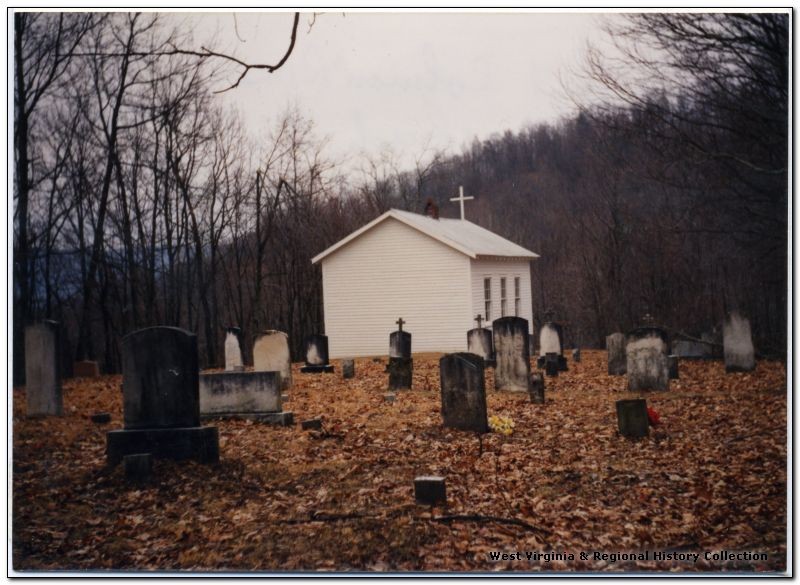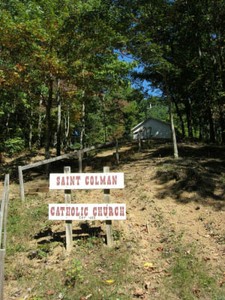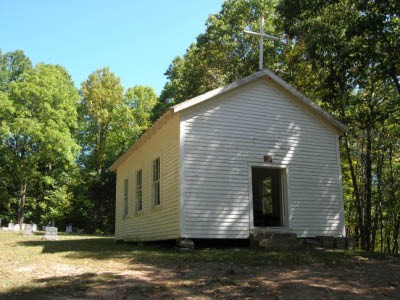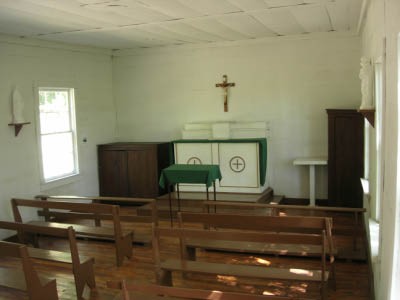Saint Colman's Church and Cemetery, The Little Catholic Church on Irish Mountan
Introduction
Text-to-speech Audio
Saint Colman’s Roman Catholic Church and Cemetery rests atop Sullivan’s Knob on Irish Mountain in Raleigh County, West Virginia. Also called the “Little Catholic Church on Irish Mountain,” this was the first Roman Catholic Church in Raleigh County. Its building began in 1877, was completed in 1878, and the church and cemetery still stand on Irish Mountain today. St. Colman’s Church and Cemetery is an important historical landmark for Raleigh County, existing as a reminder of the prominent Irish immigrant community that settled on Irish Mountain.
Images
View of St. Colman's Chapel and Cemetery

Church Sign

Front view of St. Colman's Church

Inside of the chapel

Backstory and Context
Text-to-speech Audio
Irish immigrants began moving into southern West Virginia in the early 1850’s, arriving in areas that were, at the time, essentially a wilderness. The first documented arrival to Irish Mountain was Maurice Sullivan from County Kerry, Ireland. Sullivan purchased 435 acres of land from John Qwinn in 1855 to begin the Irish Mountain settlement. Sullivan would be joined on the mountain by Irish families such as the Quinlan’s, McCarthy’s, Nee’s, Dillon’s, Carson’s, and others. The community that was formed by these families was extremely isolated, and so they formed a self-sufficient, distinctive ethnic group. The one aspect of their lives in which they felt a need was for a place of spiritual comfort. The closest Roman Catholic Church was St. Patrick’s Catholic Church in Hinton, founded in 1872, which was fifteen miles away and difficult to get to during the late 19th Century. Beginning in 1872, St. Patrick’s Church would send a priest to Irish Mountain once a month for services.
The community still felt a need for a church and a consecrated burial ground, and so in 1876 Maurice Sullivan sold for one dollar one acre of land atop the mountain to Joseph J. Kane, bishop of Wheeling, for the church and cemetery. By 1878 a small, hewn log church was completed and named after St. Colman, a popular Gaelic-Irish Saint. St. Colman’s Church never received its own priest and continued to rely on monthly visits from St. Patrick’s Church. The Irish community on the mountain existed into the 20th Century, with an average of fifteen to twenty families living in the area. The church would remain the focal point of the community on Irish Mountain. Around 1928 the original log structure was covered with clapboard siding and painted white, giving it the appearance it still has today.
Behind the church is the St. Colman’s Cemetery, which is the final resting place for the Irish community who lived and died on the mountain. The cemetery contains rows of neat tombstones, many revealing the Irish birthplace of those buried and some containing interesting inscriptions such as,
“Remember kind friends as you pass by,
As you are now, so once was I.
As I am now, so you must be.
Prepare for death, and follow me” (1).
As you are now, so once was I.
As I am now, so you must be.
Prepare for death, and follow me” (1).
St. Colman’s Cemetery also contains a “lost corner” in the rear of the cemetery of unconsecrated ground where infants and other individuals who died without baptism are buried.
The Irish immigrants would move off of the mountain in the 20th Century, but the church and cemetery remain as a visible reminder of the once thriving Irish farming community that populated the mountain. St. Patrick’s Catholic Church of Hinton continues to hold special occasion events and services at St. Colman’s Church, and maintains the grounds of the church and cemetery.
Sources
(1) http://stpatrick.hinton-wv.com/missions/st_colman.pdf
McLean, Lois C. "Irish Mountain." e-WV: The West Virginia Encyclopedia. 02 March 2012. Web. 24 January 2016.
